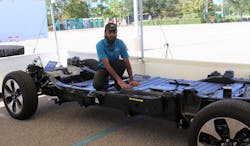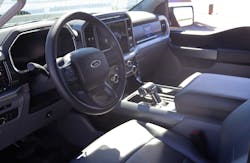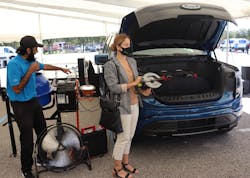Riding the Lightning Pro: First impressions of Ford's new commercial EV pickup
HOUSTON—As Mohammad Abbas, one of three on-hand subject-matter experts, quipped before sending roadshow attendees to test ride in Ford’s all-new, all-electric F-150 Lightning Pro, “I invite you all to the future of electrification at the Ford Motor Company—where we take electricity and turn it into Lightning.”
Only this Lightning is safe to ride, and quite exhilarating, too.
The manufacturer’s first electric F-Series truck, and its new E-Transit, made the trek to Houston as the last stop on its 18-city tour introducing the vehicles to dealers, fleet managers, reservation holders, and media, who learned of Ford’s planned $30 billion investment in electric vehicles through 2025, details about the vehicle’s battery options and capabilities, and the Pro’s impressive payload capacity and jobsite functionality.
Of course, the highlight was a ride in a hand-built, Lightning Pro prototype equipped with Ford’s extended-range battery that enables 0-60 mph times in the mid-4 seconds—fast enough to thrill the most ardent muscle-car enthusiasts.
But that’s not exactly what fleet managers are looking for in their new work trucks.
So FleetOwner spoke with Nathan Oscarson, Ford Pro trucks marketing manager, beforehand about Ford’s vision for how the vehicle fits into commercial fleets, which he said will benefit from a lower total cost of ownership, including reduced fuel expenses and maintenance, and the ability to quietly power multiple tools for “days and days.”
“We see a big role for the F-150 in commercial fleets,” Oscarson said. “In fact, we have the F-150 Lightning Pro, which is a fleet-centric vehicle that we built with commercial fleets in mind, and it’s at the bottom of the trim series. So if you think of our traditional XL, which is usually our fleet product for the F-150 and Super Duty, the Pro takes their place.”EV investment
Ford believes 40% of U.S. vehicle volume will be fully electric by 2030.
To prepare for our electrified future, Ford says it is investing billions into sustainable manufacturing plants, where it will produce its own batteries, and in training Ford technicians and commercial partners to service its EVs.
The crown jewels will be the $5.6 billion BlueOval City campus in Stanton, Tenn., and the $5.8 billion, 1,500-acre BlueOvalSK Battery Park, a dedicated battery manufacturing complex designed with battery supplier SK Innovation. BlueOvalSK in Glendale, Ky., will include two of Ford’s four battery-production facilities, with the others in BlueOval City, and in the Detroit area. BlueOval City will include a battery recycling plant as Ford aims to meet its lofty sustainability goals for zero-waste, emissions-free manufacturing.
Ford’s EV game plan also calls for it to spend more than $500 million, including $90 million in Texas alone, over the next five years to prepare the next generation of technicians to work on all its vehicles, including EVs, hybrids, and gas- and diesel-powered trucks. The ability to service electric and hybrid vehicles already is a key strength for Ford, which has more than 2,300 EV-certified dealerships across the country.
Subject-matter expert Max Poirier touted the F-150 Lightning’s technology-forward design, impressive acceleration, car-like handling, and jobsite functionality, while also pointing out that, like other EVs on the market, it’s less expensive to power, and boasts 40% fewer moving parts than its combustion-engine equivalent.
“What’s unique to us is our approach when it comes to electrification,” he said. “We’re electrifying by far our most important and most iconic vehicles. We started with the (Mustang) Mach-E (SUV), in terms of our passenger vehicles offerings. Of course, the Transit is the cornerstone of our 42 years of commercial van leadership—and F-150 is the pillar of our 44 years of F-Series leadership here in the United States.”
Powerful batteries
The F-150 Lightning Pro is available with standard- and extended-range batteries.
The standard battery has a targeted, EPA-estimated range of 230 miles, and the extended battery targets 300 miles. Both lithium-ion batteries are liquid cooled by a thermal management system that actively regulates battery-pack temperatures, helping support range estimates. “There are chemical reactions occurring, so we have to make sure they live in that appropriate zone,” said subject-matter expert Ian Willis. “That’s how we get the best driving range out of them—by actively managing them with this thermal management system. On hot days we can cool it down, and on cold days we can warm it up. The most common case where customers are going to see range-degradation issues is in cold weather, as it slows down the reaction of the battery, so if we bring up the temperature, we’re in better shape range-wise.”
The vehicle features a pre-conditioning system, similar to remote start, that conditions the cabin and battery for optimal comfort and performance before departure.
The standard battery targets a peak of 420 horsepower, and the extended battery targets 563 horsepower. Both versions boast 775 pound-feet of torque, and electric motors on the front and rear axles for full-time, four-wheel drive, unlike previous “intelligent” systems that alternated power between axles. “There’s so much torque on tap with Lightning that no matter how quickly we turned axles on and off, you could always feel it,” Willis said. “Just a little bit, but you could feel it, so it wasn’t as satisfying as it could be.
“The efficiency gain wasn’t as huge either, so the end decision was, make it full-time four-wheel drive, and make this thing take off like a rocket ship instead.” The result is the fastest F-150 Ford has offered, with the standard battery enabling 0-60 times in the 5-second range.
The batteries also can be submerged in up to 23 inches of water, so users can safely back their boat trailers down a ramp, or navigate water-logged dirt roads.
More importantly for fleet managers, the batteries are easily serviced by raising the vehicle, then lowering the battery compartment. “We specifically designed the batteries to be serviceable,” Willis said. “We can take the casing apart, and replace individual modules or banks of cells, so if there’s a problem in one, we don’t have to replace the whole thing, only the affected component. That’s it. That makes it cheaper to service.”What about charging, and addressing the range anxiety that comes with EV ownership? Don’t fret, Ford says.
Ford offers four options for charging Lightning and E-Transit batteries at home (or the home terminal) and on the go, and a network of Ford and partner charging stations strengthened by its June acquisition of Electriphi, a California-based provider of charging management and fleet monitoring software for electric vehicles. Ford also offers the FordPass app, which makes it easier to find and pay for charging nationwide.
The extended-range battery, which Willis said is the largest on any EV today, is equipped with dual on-board chargers that make charging it with Ford’s 80-amp Charge Station Pro take less time than charging a standard battery, at about eight hours compared to 10. “It’s also what enables intelligent backup power (for your house),” he said. “Both batteries have the hardware capacity to send power bi-directionally, but you have to make sure the house has the capability to take it on board. For us, that’s enabled through the 80-amp charge station. So even a standard-range customer can get intelligent backup power. They just have to get the 80-amp charger. That’s important.”
That’s why Ford is giving extended-range customers its Level 2 charger. “You get the big battery, you get the big charger,” Willis said.
A 150-kilowatt DC Fast-Charging Station can charge the extended-range battery to about 80% of capacity in 44 minutes, according to Ford. Willis said a Level 3 charger can add 40 miles of range in 10 minutes. FordPass also allows fleet managers to see where specific trucks are charging. “If they’ve got four or five drivers who all drive a Lightning or electric van, and they pull into one of the Ford network’s charging stations, that station will determine who the vehicle is associated with, and which fleet manger the billing goes to,” Oscarson said.
Lightning Pro batteries are backed by a comforting eight-year, 100,000-mile warranty.
Workhorse functionality
The all-new, reengineered chassis was designed specifically for the F-150 Lightning, and now features an upgraded, high-strength steel frame to support the battery, and to protect it in a collision and from debris.
The extended-range battery, which weighs approximately 1,800 pounds, sits in the middle of the chassis, giving the Lightning a well-balanced, lower center of gravity than a conventional F-150 with an engine under the hood. “Balance, in my opinion, is what really sets this truck apart from its gasoline equivalent,” Abbas said. It also features the first F-Series independent rear suspension. “It literally drives with an agility and grace a truck that size has do business doing,” Poirier said.The Lightning, with a curb weight of nearly 6,500 pounds, weighs 1,300 pounds more than its gas equivalent, yet offers almost 500 pounds more payload capacity, Abbas said, with about 2,000 pounds of capacity in the bed and 400 in the “frunk.”
And this is no ordinary front trunk—it’s Ford’s first “Mega Power Frunk” on an F-Series truck.
What used to house an engine now is a high-tech cargo area with four 120-volt AC Pro Power Onboard outlets and two USB ports, and a total of 2.4 kilowatts of available power. In his demonstration, Abbas, also a professor at Georgian College-Automotive Business School of Canada, had a 1,500-watt table saw, 110-watt fan, 130-watt cement mixer, and 500-watt flood light all plugged in. If two accessories that exceed the 2,400-watt capacity are turned on simultaneously, a breaker in the frunk trips. “If it ever goes over capacity, everything shuts off, just like it would in your home, but you push this green button, and it resets,” Abbas said.
Mega-frunk power is in addition to, and completely separate from, an available 7.2 kilowatts of power at the back of the truck, with 3.6 in the cabin and 3.6 in the bed, where two more 120-volt outlets and a 240-volt AC outlet are located. “Technically, you could use Lightning to charge another electric vehicle,” Abbas pointed out.
Should Pro Power Onboard—which Ford says has enough power to “rip up to 30 miles of half-inch plywood on a single charge” with the extended-range battery—deplete the charge level to the point the truck cannot reach a charge location, it will shut down automatically, or based on a pre-determined setting to prevent the truck from becoming stranded.
“It’s like a nuclear reactor on wheels because you have a total of 9.6 kilowatts of usable power,” Abbas said. “So when we have fleet customers come through, even they’re surprised, and asking ‘What are we going to do with that much energy?’”Commercial appeal
Ford’s ideal commercial customers include construction companies and government agencies with work-truck fleets. In addition to jobsite functionality, without the need for a noisy generator, they’re going to be most appreciative of the Lightning’s lower total cost of ownership compared to conventional trucks, Oscarson said.
“Retail customers tend to buy on emotion, but fleets buy off a spreadsheet, and with good reason,” he said. “So if you go through the advantages with that low cost of ownership, first off, you’re not putting gas in the tank, and we’ve seen what’s happened with gas prices lately. Another advantage is, not only are you using electricity, but you can program the vehicle not to charge until a certain time (for off-peak rates).”
And fleet managers will be able to monitor the trucks to make sure they’re charging as scheduled.
“Fleets that subscribe to our Ford Pro Intelligence will able to go in and, for example, if the driver didn’t plug the vehicle in at night, have a text sent to the manager, or more likely the driver … reminding them, ‘Hey, you forgot to plug this in, so go plug it in,’ to make sure there are no issues with the state of the charge,” Oscarson said.
The vehicles also will help companies reduce their carbon footprints, and because they produce zero emissions, they can enter warehouses or manufacturing facilities where only propane forklifts could go before. And because they have fewer moving parts than combustion-powered vehicles, there are fewer parts to replace, and fewer routine maintenance items. “You don’t have the internal combustion engines, so there’s no oil changes, and the brakes are regenerative, so they’re going to last longer between replacing the pads, and you don’t have a traditional transmission, so you’re not going to have transmission issues.
“So the reduction in maintenance is huge for fleets.”
The truck is not available without the 5.5-foot rear cargo bed, but familiar F-150 dimensions and mounting points simplify upfitting with toolboxes or ladder racks that are new, or borrowed from conventional F-150s.Oscarson says the interest they’ve seen from prospective customers is “phenomenal,” with Ford reportedly booking 150,000 customer reservations for the Lightning, which will start to roll off the same line as conventional F-150 bodies at the truck plant in Dearborn, Mich., in the spring of 2022—with a starting MSRP of $39,974 for the standard-range-battery Lightning Pro, and $49,974 for the extended-range-battery version.
In addition to the truck’s 2,000-pound payload capacity, which is monitored by on-board scales, the extended-range Lightning will have a maximum available towing capacity of 10,000 pounds, and a GPS-enabled “smart” range calculator.
“Definitely, towing decreases your range,” Oscarson said. “So our system is smart enough to know when you’re towing something. You’ll plug it in, and then tell the computer how much it weighs, and it will factor that information into a bunch of other scenarios to figure out an accurate range to empty. It will look at weather, how you’ve been driving in the past, the terrain you’re going to go over, and how much you’re towing to give you a very accurate idea of what your state of charge is, and how much you’re drawing it down.
“The last thing we want is for someone to be stranded and run out of charge without enough prior warnings.”
This article originally appeared on FleetOwner.com.








